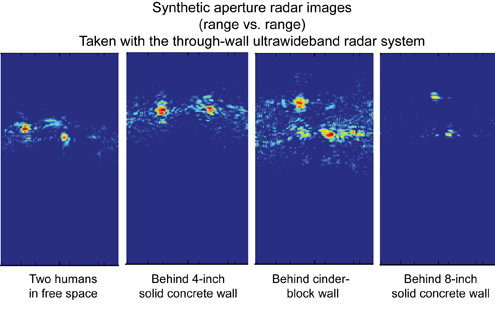MIT Lincoln Laboratory researchers have developed a new radar system that looks through walls. This ultrawideband (UWB) phased-array sensor has real-time acquisition and processing capability and provides video-like synthetic aperture radar (SAR) images of people moving behind an 8-inch-thick cinder block or concrete wall.
The system demonstrated the ability to capture meaningful imagery at a 10.8 Hz frame rate through 4-inch- and 8-inch-thick, as well as cinder block, walls from a standoff distance of approximately 20 feet, but is estimated to work up to 60 feet away.
Dr. Gregory Charvat, who developed the system along with colleagues John Peabody and Tyler Ralston of Lincoln Laboratory’s Aerospace Sensor Technology Group, says, “We estimate the maximum range to be approximately 60 feet when looking through an 8-inch concrete wall.”
The technology will be useful for providing soldiers or emergency responders in urban environments with increased awareness of activity inside or behind structures, says Charvat. “Such a system could reduce mission risk for soldiers in the urban environment and help to save lives.”
The system exploits a well-known fact: while it is not possible to see through walls by using visible light, it is possible by using larger micro-wavelengths to radiate into a wall and receive a weak scattered signal that is representative of what is behind the wall.
http://www.ll.mit.edu/news/thruwallradar.html


